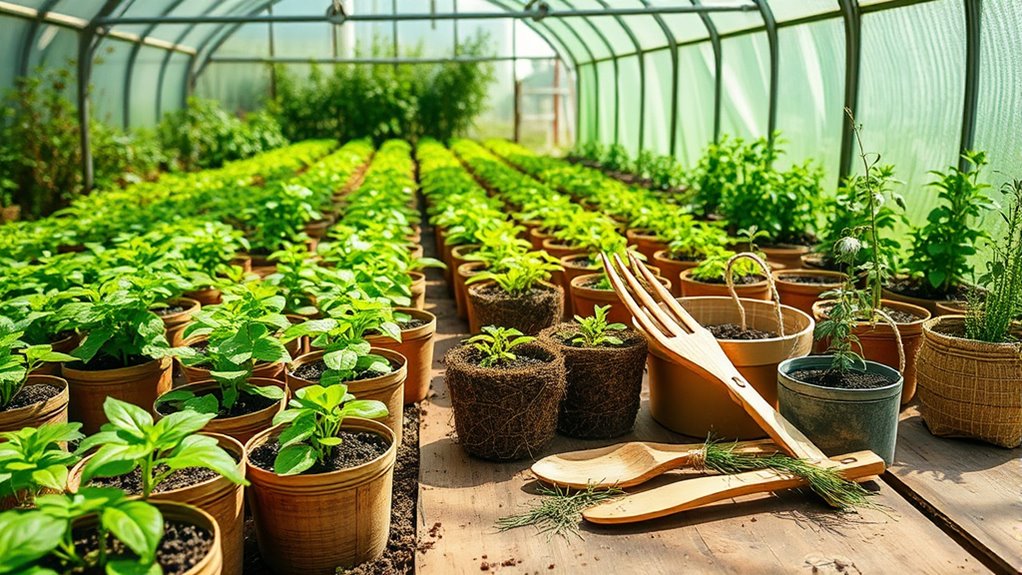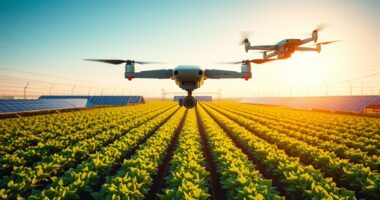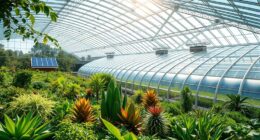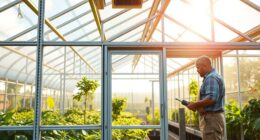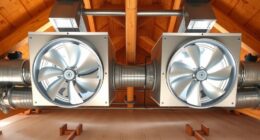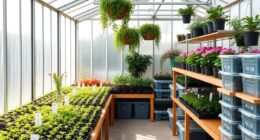As an eco-conscious gardener, I love using biodegradable greenhouse products that help the environment while nurturing my plants. Some top choices include the Green Self-Watering GrowBoxes, GROWNEER peat pots, and versatile seedling starter trays. These products promote healthy growth and minimize transplant shock, making my gardening experience seamless. I've found they really enhance moisture retention, too. If you're curious about more options and factors to evaluate, stick around, and I'll share additional insights!
Key Takeaways
- Biodegradable seedling starter trays promote strong root growth while allowing direct planting, minimizing disturbance during transplantation.
- Self-watering grow boxes simplify plant care with automatic hydration, suitable for various gardening skill levels and environments.
- Biodegradable paper weed blockers maintain soil moisture and reduce weeds, providing an eco-friendly alternative to plastic barriers.
- Indoor gardening solutions, like the Ferry Morse Greenhouse, utilize biodegradable peat pellets for efficient seed germination in compact spaces.
- Utilizing biodegradable products in gardening reduces plastic waste and supports sustainable practices for a healthier ecosystem.
2 Green Self-Watering GrowBoxes

If you're looking for a gardening solution that simplifies the process while being environmentally friendly, the Green Self-Watering GrowBoxes are perfect for you. I love how they come with an automatic self-watering and fertilizing system, making plant care effortless. You can grow anything from vegetables to flowers without the hassle of weeding or bending. Setting it up takes less than five minutes! Plus, the 4-gallon reservoir lasts longer than most competitors, ensuring my plants thrive. They're accessible for people of all ages, even those with physical limitations. It's truly a clean and easy gardening experience that I highly recommend!
Best For: Individuals seeking an easy and efficient gardening solution, particularly those with physical limitations or limited gardening experience.
Pros:
- Automatic self-watering and fertilizing system simplifies plant care.
- Quick and easy setup in under 5 minutes, ideal for busy lifestyles.
- Suitable for all ages and gardening skill levels, promoting accessibility.
Cons:
- Customer feedback mentions occasional issues with missing items.
- Some users reported difficulties in getting timely support for concerns.
- Limited color options may not appeal to all aesthetic preferences.
Self-Watering GrowBoxes with Natural Fertilizer and Staking Kit (5 Grow Boxes)

For anyone looking to simplify their gardening experience, the Self-Watering GrowBoxes with Natural Fertilizer and Staking Kit is an excellent choice. With five grow boxes, this kit features a self-watering system that includes a 4-gallon water well, ensuring your plants thrive without constant attention. The unique cover protects the natural fertilizer from rain, providing essential nutrients effortlessly. Plus, you don't need any gardening skills—it's perfect for growing vegetables, flowers, or herbs. Whether indoors or outdoors, these versatile boxes eliminate weeding, making your gardening journey clean and low-maintenance. I can't recommend them enough for consistent and successful gardening!
Best For: Individuals seeking an easy and low-maintenance gardening solution, especially those with physical limitations or no prior gardening experience.
Pros:
- Self-watering system provides consistent hydration, reducing the need for frequent watering.
- Natural fertilizer promotes healthy plant growth without the hassle of chemical additives.
- Versatile usage allows for both indoor and outdoor gardening in various locations.
Cons:
- The initial investment may be higher compared to traditional gardening methods.
- Limited to the size and number of plants that can be grown in the provided boxes.
- May require occasional monitoring to ensure the water well remains filled adequately.
10 Packs Biodegradable Seedling Starter Trays
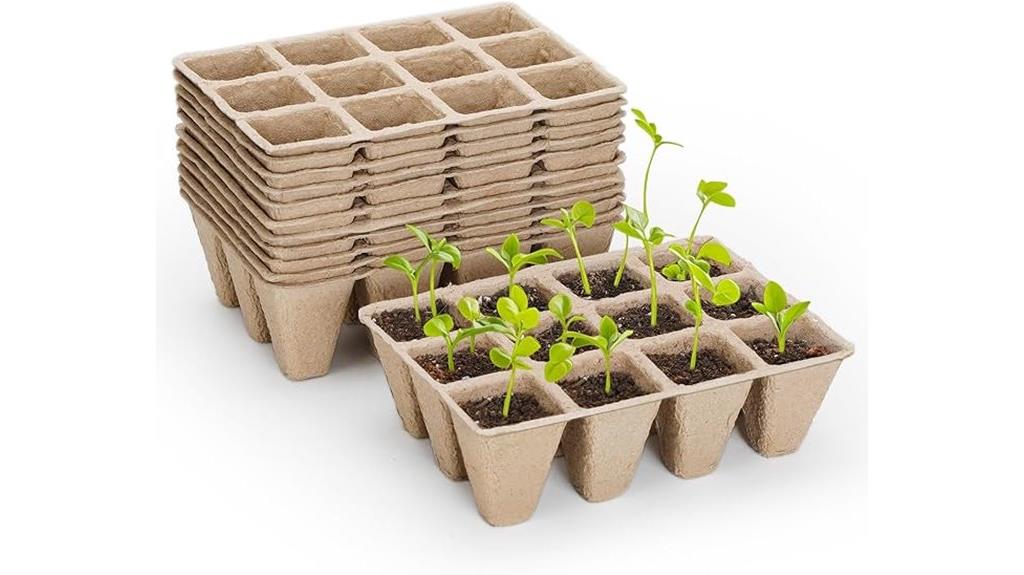
Gardeners seeking an eco-friendly option for starting seedlings will find the 10 Packs Biodegradable Seedling Starter Trays an ideal choice. With 120 cells crafted from sustainable materials, these trays promote excellent germination and support young plants until it's time to transplant. I love how they encourage strong root growth and fit perfectly in standard 1020 trays. They maintain moisture well, making sure my seedlings thrive. While some users noted the trays are slightly smaller than standard ones, I've had great success with early planting, and I appreciate being able to plant them directly in the ground without disturbing roots.
Best For: Gardeners and professional growers looking for an eco-friendly seedling starter solution.
Pros:
- Biodegradable materials allow for direct planting without root disturbance.
- Tapered cells support strong root growth and fit into standard 1020 trays.
- Excellent moisture retention promotes healthy seedling development.
Cons:
- Trays are smaller than standard nursery trays, which may limit use for larger seedlings.
- Considered okay value with no particularly standout features.
- Some users may find the quality lacks special attributes, despite holding shape well.
GROWNEER 288 Cells Peat Pots Seed Starter Trays

The GROWNEER 288 Cells Peat Pots Seed Starter Trays are perfect for anyone looking to cultivate a thriving garden, whether you're a seasoned pro or just starting out. With 288 cells across 24 packs, these biodegradable pots make it easy to start flowers, herbs, and veggies like tomatoes and cucumbers. I love how they promote aeration, reducing transplant shock when moving seedlings to the garden. Plus, you can cut them into individual pots, making gardening even simpler. Just keep an eye on moisture levels to avoid overwatering, and you'll enjoy successful germination while being eco-friendly!
Best For: Gardeners looking for an eco-friendly and efficient way to start their seedlings, whether for flowers, herbs, or vegetables.
Pros:
- Biodegradable material promotes environmental sustainability.
- Reduces transplant shock, aiding seedling health during transfer to the garden.
- Easy to use and can be cut into individual pots for convenience.
Cons:
- May break down quickly in warm climates, affecting usability.
- Some users report premature breakdown and white residue after watering.
- Larger pots may be needed for better root growth and stability.
winemana Seed Starter Peat Pots with Humidity Dome and Labels (36 Set)

If you're looking for an eco-friendly way to start your garden, winemana Seed Starter Peat Pots with Humidity Dome and Labels offer a practical solution. This 36-set includes biodegradable pots, clear humidity domes, and labels for easy monitoring. The pots are designed to minimize transplant shock, allowing roots to grow undisturbed. While some users noted that the domes can be a bit loose, I found that a rubber band fixed that issue. With quick germination for herbs and the ability to mark seedlings, these pots provide excellent value for just $18. Overall, I'm satisfied and would buy them again!
Best For: Gardeners seeking an eco-friendly and efficient way to start seeds indoors or outdoors.
Pros:
- Biodegradable pots that provide organic nutrients upon transplanting.
- Clear humidity domes allow for observation of plant growth while retaining moisture.
- Includes labels for easy identification and marking of seedlings.
Cons:
- Some users reported that the humidity domes do not fit securely and may require rubber bands to stay in place.
- Germination rates vary, with some users experiencing only about 50% sprouting.
- Mixed reviews on the durability of the pots, with suggestions for improvement noted.
Back to the Roots 12-Cell Greenhouse Germination Kit
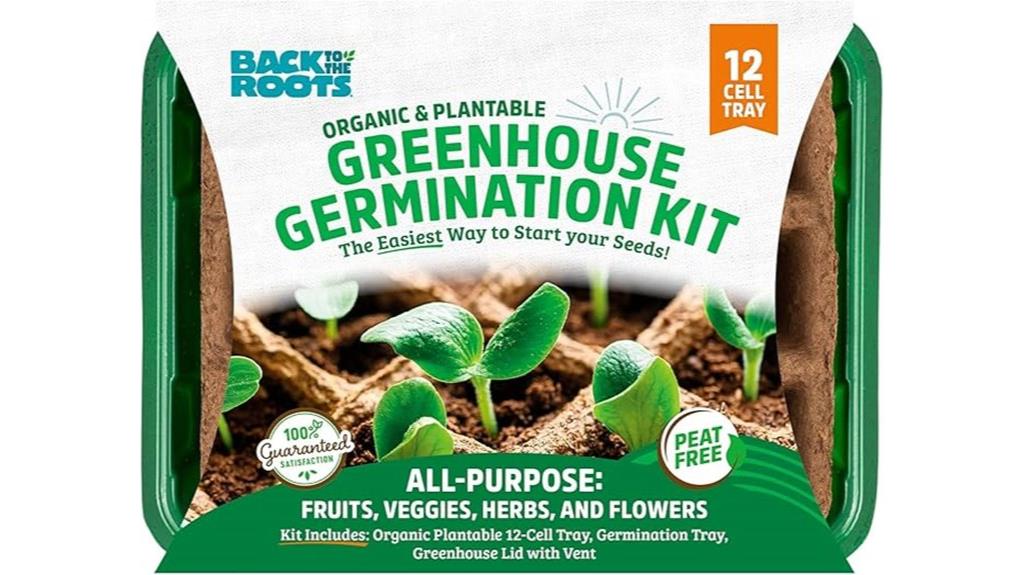
Looking for an eco-friendly way to kickstart your plants? The Back to the Roots 12-Cell Greenhouse Germination Kit is a fantastic choice! Made from 75% recycled plastic and 100% compostable, it features biodegradable pots and a vented lid for ideal humidity control. I love that it eliminates transplanting stress since you can plant directly into the soil. Perfect for herbs, veggies, flowers, and fruits, this kit helps grow strong, healthy roots. Plus, their customer support guarantees growth, ensuring satisfaction. I can't wait to share my garden photos and contribute to their #GROWONEGIVEONE initiative!
Best For: Eco-conscious gardeners looking to start their plants in an easy and sustainable way.
Pros:
- Easy transfer to pots, minimizing transplanting stress.
- Made from 75% recycled plastic and 100% compostable materials.
- Vented lid allows for excellent humidity control, promoting healthy growth.
Cons:
- Some users report flimsy plastic that may affect durability.
- Issues with the fit of the lid have been noted.
- Requires separate purchase of soil, fertilizer, and seeds for use.
Seed Starter Kit with 100 Peat Pots and Plastic Growing Trays

Perfect for novice gardeners and seasoned green thumbs alike, the Seed Starter Kit with 100 Peat Pots and Plastic Growing Trays provides everything you need to kickstart your planting journey. This kit includes biodegradable peat pots that are perfect for herbs, flowers, and vegetables. Each pot features drainage holes, promoting healthy root growth. I love that the pots break down easily in the soil, so you can plant them directly without damaging the roots. Plus, the waterproof plant labels are super handy for keeping track of my plants. Overall, it's an eco-friendly choice that makes gardening simple and enjoyable!
Best For: Novice gardeners and experienced horticulturists looking for an eco-friendly and convenient way to start their plants.
Pros:
- Biodegradable peat pots promote healthy root growth and can be planted directly in the ground.
- Complete setup includes 100 pots, trays, plant labels, and a humidity dome for optimal growing conditions.
- Waterproof plant labels are reusable, making it easy to track different plant species.
Cons:
- Some users reported sizing discrepancies with the peat pots.
- A few customers experienced missing components, such as the seed sorter.
- Limited feedback suggests potential durability issues with the plastic trays over time.
10 Packs Biodegradable Seedling Starter Trays
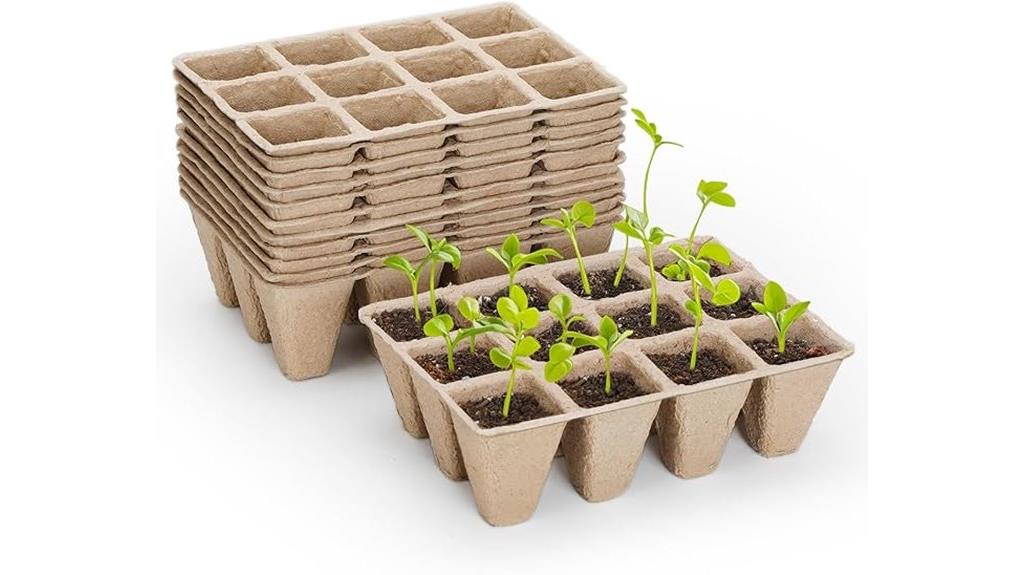
For gardeners who prioritize sustainability, the 10 Packs of Biodegradable Seedling Starter Trays offer an eco-friendly solution that promotes healthy seedling growth. With 120 cells designed to encourage strong root development, these trays are perfect for various seeds. I appreciate how they maintain moisture well, allowing for effective germination. While some users mention they're smaller than standard nursery trays, I've found them functional for most seedlings. Plus, I love that I can plant them directly into the ground, minimizing root disturbance. Overall, these trays provide solid value for anyone looking to start their garden sustainably.
Best For: Gardening enthusiasts and professional growers looking for an eco-friendly seedling starter solution.
Pros:
- Made from biodegradable materials, allowing for planting directly in the ground.
- Tapered cells promote strong root growth and fit into standard trays.
- Excellent moisture retention for effective germination and seedling development.
Cons:
- Smaller than standard nursery trays, which may not accommodate larger seedlings.
- Considered okay value with no standout features.
- Some users reported that the size limitations could hinder certain planting projects.
EBaokuup Biodegradable Seeding Starter Pots (40pcs)

If you're passionate about sustainable gardening, the EBaokuup Biodegradable Seeding Starter Pots are an excellent choice. With 40 sturdy pots made from recycled pulp, they're designed to support your seedlings while being eco-friendly. Each pot features a drainage system to manage moisture, promoting healthy growth. The included transparent humidity domes help maintain ideal conditions for germination, allowing you to keep an eye on your plants. These pots are versatile, perfect for flowers, herbs, or veggies. Plus, they decompose quickly when planted, enriching the soil. I highly recommend them for anyone looking to cultivate a greener garden!
Best For: Eco-conscious gardeners looking for sustainable and biodegradable options for starting their plants.
Pros:
- Sturdy construction ensures effective drainage and supports healthy plant growth.
- Transparent humidity domes allow for easy monitoring of moisture and temperature, enhancing germination rates.
- Biodegradable materials enrich the soil as they decompose, promoting an eco-friendly gardening practice.
Cons:
- Some customers reported issues with the fit and durability of the humidity domes, leading to concerns about their effectiveness.
- Lids may not stay securely in place, which could affect moisture retention.
- Limited to smaller plants, which may not meet the needs of gardeners looking for larger planting solutions.
3 x 100 Ft Biodegradable Paper Weed Blocker Grass Barrier

The 3 x 100 Ft Biodegradable Paper Weed Blocker Grass Barrier stands out as an ideal choice for environmentally conscious gardeners looking to maintain healthy plants while minimizing their ecological footprint. Made from biodegradable craft paper, it naturally breaks down after the season, leaving no harmful plastic bits behind. I love how it retains ground moisture, promoting robust plant growth. Its durable construction allows me to kneel or walk on it without tearing. Plus, with generous dimensions, it covers various gardening needs effortlessly. This barrier transforms my garden into a thriving space, all while being eco-friendly and user-friendly.
Best For: Eco-conscious gardeners who want to promote healthy plant growth while minimizing their environmental impact.
Pros:
- Eco-friendly: Made from biodegradable craft paper that leaves no harmful waste.
- Durable: Thick construction allows for walking or kneeling without tearing.
- Versatile coverage: Generous dimensions of 3×100 feet cater to various gardening needs.
Cons:
- Seasonal use: Needs to be replaced after one season as it biodegrades.
- Limited longevity: May not withstand extreme weather conditions for extended periods.
- Initial soil preparation required: May need some soil addition before placement for optimal effectiveness.
Ferry Morse Jiffy Seed Starting Windowsill Greenhouse with 10 Biodegradable Peat Pellets (5 Pack)

Looking for an efficient way to kickstart your indoor gardening? The Ferry Morse Jiffy Seed Starting Windowsill Greenhouse is a fantastic choice. With five greenhouses and fifty biodegradable peat pellets, I find it perfect for growing herbs, flowers, and vegetables right at home. Just add warm water to expand the pellets, sow your seeds, and cover them with the clear humidity dome for ideal growth. I love that the peat pellets help with aeration and water retention, making germination easier. Although some users mention the plastic can be a bit flimsy, it still functions well for small spaces.
Best For: Ideal for beginners and experienced gardeners looking to start herbs, flowers, and vegetables indoors.
Pros:
- Easy to use with a straightforward seed starting process.
- Biodegradable peat pellets promote efficient germination and healthy root development.
- Compact design suitable for small spaces, making it perfect for windowsills.
Cons:
- Some users find the plastic containers to be flimsy.
- Seeds are not included, requiring additional purchases.
- Limited capacity may not meet the needs of larger gardening projects.
GROWNEER 72 Cells Peat Pots Seed Starter Trays

For gardeners seeking an eco-friendly solution to seed starting, GROWNEER 72 Cells Peat Pots Seed Starter Trays stand out as an excellent choice. Each tray contains six cells, perfect for starting flowers, herbs, and even vegetables like tomatoes and cucumbers. I love that they're 100% biodegradable, allowing me to transplant them directly into the ground without harming the environment. However, I recommend being cautious with watering, as overwatering can cause the trays to lose their structure. With 15 plant labels included, these trays make it easy to keep everything organized. Just remember to check the dimensions before purchasing!
Best For: Gardeners looking for an eco-friendly and efficient seed starting solution.
Pros:
- 100% biodegradable, allowing for direct transplanting into the ground.
- Includes 15 plant labels for easy organization of seedlings.
- Designed to prevent transplant shock and promote aeration for optimal growth.
Cons:
- Trays are smaller than expected, approximately 2×2 inches.
- Overwatering can cause the trays to lose structure.
- Some users experience issues with moisture retention.
130 Pcs Organic Peat Pots for Seedlings

If you're enthusiastic to start your gardening journey, the 130 Pcs Organic Peat Pots are a fantastic choice for anyone passionate about nurturing seedlings. Made from natural recycled pulp paper, these biodegradable pots breathe like clay and won't harm the environment. Each pot measures 3.15 inches in diameter and comes with four drainage holes, promoting healthy root growth and preventing transplant shock. I love how easy they make transferring seedlings to the garden. Plus, with 130 planting labels included, you can keep track of your plants effortlessly. They're perfect for both indoor and outdoor gardens, making gardening accessible for everyone!
Best For: Gardening enthusiasts and beginners looking for eco-friendly and biodegradable pots for starting seedlings.
Pros:
- Made from natural recycled pulp paper, making them environmentally friendly and biodegradable.
- Features four drainage holes in each pot to enhance air circulation and prevent root damage.
- Includes 130 planting labels for easy plant identification and organization.
Cons:
- Some users reported size discrepancies compared to other pots, which may affect compatibility.
- The pots may require soaking before planting for optimal performance.
- Not as sturdy as plastic pots, which could be a concern for some gardeners during handling.
Jucoan 40 Pack Peat Pots Seed Starter Trays

The Jucoan 40 Pack Peat Pots Seed Starter Trays are perfect for gardeners who want an eco-friendly option for starting their seeds. With 40 trays and 12 cells each, I can efficiently start a variety of flowers, herbs, and vegetables like tomatoes and cucumbers. Made from biodegradable materials, these pots retain moisture well and enrich the soil as they decompose. I love that I can transplant the entire tray without disturbing the roots. However, I've noticed they can be a bit small and may disintegrate if overwatered. Overall, they offer great value for eco-conscious gardening enthusiasts like me.
Best For: Eco-conscious gardeners looking for an affordable and biodegradable option to start seeds for flowers, herbs, and vegetables.
Pros:
- Made from biodegradable materials, allowing for easy transplantation without root shock.
- Retains moisture well, helping to promote healthy seed germination.
- Cost-effective with 40 trays and 12 cells each, providing ample capacity for starting seeds.
Cons:
- Pots may be too small for larger seedlings and can disintegrate if overwatered.
- Some users have reported difficulties in separating pots without tearing them.
- Durability concerns during transplantation may complicate the process for some gardeners.
Factors to Consider When Choosing Biodegradable Greenhouse Products

When choosing biodegradable greenhouse products, I think it's essential to take into account several key factors. Material sustainability, size options, and ease of use all play a significant role in ensuring your gardening efforts are effective and eco-friendly. Plus, features like drainage and aeration, along with the overall environmental impact, shouldn't be overlooked.
Material Sustainability Considerations
Choosing biodegradable greenhouse products involves careful consideration of material sustainability, as selecting the right components can greatly impact both your garden and the environment. I prioritize materials made from natural, recycled, or organic sources, like pulp paper or plant-based options, to minimize ecological harm. Look for items certified as compostable or biodegradable, guaranteeing they break down naturally without leaving harmful residues. It's also critical to assess durability since some biodegradable materials may degrade quickly in warm, moist conditions, affecting their effectiveness. I consider water retention and aeration properties, which are crucial for healthy plant growth, and guarantee adequate drainage features to prevent waterlogging that can harm seedlings. Making informed choices really pays off in the long run!
Size and Capacity Options
Understanding size and capacity options is essential for selecting the right biodegradable greenhouse products. When I choose trays or pots, I pay attention to cell sizes and dimensions, as these can greatly affect what seedlings I can grow. For instance, some trays offer up to 288 cells, allowing me to start numerous plants at once. I also make sure to pick pots with adequate drainage holes to promote healthy root systems and prevent waterlogging. It's vital to select products designed for specific plant types, as the right size and shape can influence growth patterns. Finally, I consider the durability of biodegradable materials; I want them to last long enough to support my seedlings without breaking down prematurely.
Ease of Use
Although gardening can seem intimidating, selecting biodegradable greenhouse products that are easy to use can make the process enjoyable and straightforward. Many of these products come with simple designs that require minimal setup, perfect for beginners like me. For instance, seed starter trays allow me to transplant directly into the soil without disturbing the roots, which simplifies the gardening experience. I also appreciate products with integrated humidity domes that help maintain ideal moisture levels. Trays designed for easy separation minimize the risk of damaging delicate seedlings, enhancing convenience. Plus, features like clear observation windows and built-in drainage systems make monitoring and maintaining my plants easier, even without extensive horticultural knowledge.
Drainage and Aeration Features
When selecting biodegradable greenhouse products, paying attention to drainage and aeration features is essential for healthy plant growth. Effective drainage systems, like pots with multiple drainage holes, prevent waterlogging and promote robust root development by allowing excess moisture to escape. Aeration plays a vital role too, ensuring oxygen reaches the roots; pots made from breathable materials facilitate air circulation in the soil. I also find that tapered cell designs in seedling trays encourage strong root growth and prevent roots from becoming root-bound. Proper drainage and aeration help reduce transplant shock, allowing plants to adapt better in well-draining environments. Additionally, trays that retain moisture while providing adequate drainage optimize seedling development and prevent overwatering, striking the perfect balance for thriving plants.
Biodegradability and Environmental Impact
Choosing biodegradable greenhouse products not only benefits your garden but also plays a crucial role in reducing our environmental footprint. These products, made from materials that naturally decompose, help minimize plastic waste and lessen environmental harm over time. When I use options crafted from recycled pulp or organic materials, I notice they enhance soil quality by releasing important nutrients as they break down. Additionally, these products considerably lower the carbon footprint tied to traditional plastic supplies, promoting sustainable gardening practices. However, it's important to remember that biodegradability can vary based on environmental conditions. Products designed for soil may not decompose well in waterlogged or excessively dry conditions. Opting for biodegradable options supports a circular economy, returning materials to the earth instead of adding to landfills.
Versatility for Plant Types
To successfully cultivate a diverse garden, it's important to take into account the versatility of biodegradable greenhouse products. I've found that choosing products that accommodate various plant types—like vegetables, herbs, and flowers—maximizes usability. Trays and pots with tapered cells encourage strong root growth, making them suitable for different seedlings. Additionally, I look for products that promote ideal moisture retention and aeration, essential for diverse seed types during germination. The ability to transplant seedlings directly into the ground without disturbing their roots is critical for minimizing transplant shock across plant species. Finally, versatile designs that work for both indoor and outdoor use make these biodegradable products even more effective for gardeners like us, adapting to various environments.
Cost-Effectiveness and Value
With the versatility of biodegradable greenhouse products established, I now turn my attention to their cost-effectiveness and overall value. When evaluating these products, I always consider the quantity offered; packs with multiple seed starter trays can notably lower the cost per unit. Durability matters too—products that maintain their structure during use often justify a higher price. I also look for features like humidity domes or drainage systems, as they can boost plant growth and reduce replacement needs. Additionally, I assess the environmental benefits since products that decompose naturally align with my sustainability goals and can save on waste disposal costs. Finally, I check user feedback to find options that deliver both functionality and affordability.
Frequently Asked Questions
Are Biodegradable Greenhouse Products Safe for All Plant Types?
I've found that biodegradable greenhouse products are generally safe for most plant types. They're designed to break down naturally, enriching the soil over time. However, I always check the specific materials used, as some plants might be sensitive to certain additives. When I first started using these products, I noticed healthier growth in my plants. It's important to do a little research and choose wisely, but overall, I've had great success!
How Long Do Biodegradable Products Last in the Garden?
Like the fleeting beauty of a cherry blossom, biodegradable products in the garden typically last anywhere from a few months to a couple of years, depending on their material and conditions. I've found that things like plant pots or mulch break down at different rates. It's crucial to take into account factors like moisture and temperature, as they can accelerate or slow down decomposition. I always check on my products to verify they're still doing their job!
Can I Use Chemical Fertilizers With Biodegradable Pots?
I've often wondered about using chemical fertilizers with biodegradable pots. I've found that it's generally not recommended. The chemicals can break down the pots too quickly, preventing them from doing their job. Instead, I prefer organic fertilizers that nourish my plants without harming the pot's structure. This way, I can enjoy the benefits of biodegradable pots while promoting a healthier garden ecosystem. It's a win-win for me!
Are Biodegradable Products More Expensive Than Traditional Options?
I often wonder if biodegradable products are pricier than traditional options. From my experience, they can be a bit more expensive upfront, but I've found that the long-term benefits outweigh the costs. Using biodegradable materials has helped reduce waste and foster a healthier environment. Plus, supporting sustainable practices feels rewarding. So, while the initial price might be higher, I believe it's worth it for the positive impact on our planet.
How Do I Dispose of Biodegradable Products After Use?
Disposing of biodegradable products is pretty straightforward. I usually check if they can go in my compost pile, which is a great way to recycle nutrients back into my garden. If they're not compostable, I toss them in the trash, where they'll break down naturally over time. I've learned to look for local disposal guidelines too, as some areas have specific facilities for biodegradable materials. It all feels good for the planet!
Conclusion
In the world of eco-friendly gardening, choosing biodegradable greenhouse products can truly make a difference. I've seen firsthand how these tools not only nurture our plants but also help protect our planet. By opting for sustainable options, we're not just planting seeds; we're sowing the seeds of change. So, whether you're a seasoned gardener or just starting out, remember that every little bit helps. Let's dig deep and cultivate a greener future together!
